Best viewed using:
Internet Explorer
or
Mozilla Firefox
Connecting the NLA8063 & NLD8063 Catenary Spark Simulators
This novel lighting simulation idea was first suggested to us by Mr. Mark Mills of Australia, who wanted to reproduce this effect for a trolley on their club layout. We thought it was such a unique application for our simulators that we asked Mr. Mills if we could offer it to other hobbyists as well. In keeping with the sharing spirit that has made this hobby what it is, he graciously agreed. Our thanks to him for his creative idea his generosity in allowing us to share it.
Installing the NLA8063 is very straightforward. Its tiny size and thin construction will allow it to be placed in many spaces too small for even the smallest Z-scale decoder. Because the module has circuitry on both sides, care must be taken to be sure that the components or wires soldered will not make contact with any metal object (such as a locomotive frame) causing a short circuit.
Included with the module are two 6” lengths of #32 insulated wire. If necessary, these can be used for power input wires.
NLA8063 (analog) input power connections:
The NLA8063 Simulator is configured for analog (DC) operating environments. They will function normally with track voltages ranging from 3.2 to 16-volts DC. The circuit includes a Schottky barrier diode to protect the module from reverse input voltage polarity. This means when it is wired the normal "engineer's side is the +DC track side", the effect is fully operational. when running in reverse "fireman's side is the +DC track side) the effect is not in operation. For many lighting effects, this will not be a problem because they are intended for forward operation.
For those effects that need full bi-directional operation, one of our N8101 DC Power Source circuits can be added in front of the effect simulator board to eliminate DC polarity issues. The N8101 contains a very-low voltage-drop Schottky bridge rectifier which will slightly raise the startup voltage threshold of the lighting effect by about 0.2-0.4 volts. Figure 2 below below is schematic diagram of the connections required.
All solder connections explained below
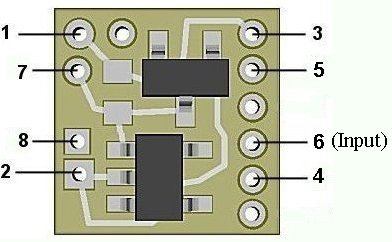
Figure 1
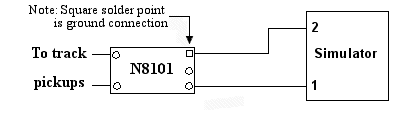
Figure 2
NLD8047 (DCC/RC) input power connections:
The NLD8047 Simulators are configured for DCC environments and sound decoders having 3.3-volt accessory functions They have an on-board jumper in place of the barrier diode used in the analog version. This allows them to operate fully at 3.3-volts (even slightly, below allowing for LED brightness). Since track polarity is not a factor in DCC the need for this protection is not required. Also, in an RC modeling environment, battery power is known so this is not an issue. However, since this family of Simulators doesn't have polarity protection, care must be taken during wiring to ensure polarity is correct before power is applied. Otherwise, the circuitry will be damaged. Figure 3 below shows the front side of the NLD8047 with the jumper installed and the barrier diode not installed.
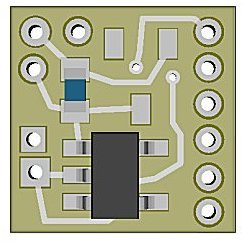
Figure 3
In a DCC environment, most wired decoders have a blue wire which is the common connection for all wired functions (F0, F1, etc.). It is the + DC connection and will be connected to solder point #1 as shown in Fig. 1.
If the decoder is a “drop-in” style without wires, consult the decoder manual and use the blue wire supplied to connect point #1 to the appropriate + solder pad.
If the solder pad has a resistor in series with it, be sure to connect the blue wire behind the resistor (see Fig. 4). This will ensure full voltage is supplied to the module.
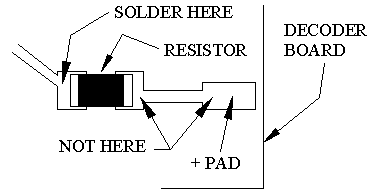
Figure 4
Important note: A low-wattage iron with a pointed tip should be used for connection of wires. Too much heat or solder can easily damage the wires, decoder or module and void the warranty.
Also, all connecting wires should be pre-tinned before soldering them to the module. This will make connection quick and easy and ensure excessive heat is not applied to the solder points.
Next, choose the function you want to control the NLD8047 module and connect the appropriate function wire to solder point #2. For example: If you want F1 to turn on the Simulator, connect the green wire to #2.
Again, if the decoder is the drop-in style, use the enclosed green wire to connect the appropriate function solder pad to #2. Make sure the pad chosen for this connection is not a “+” pad , but a function pad (– DC connection).
Whichever function you choose, make sure it is programmed for On/Off control only. Do not program the function for special effects. The NLD8047 will control the special effects.
Connecting LEDs
When connecting the LEDs, proper polarity must be observed. LEDs are “polarity sensitive” and will not function is connected backwards. The NLA/D8063 is configured to connect two 20 ma LEDs with device voltages of 3.2-3.3 VDC. This covers all of Ngineering’s Micro and Nano white LEDs, as well as many of the white LEDs available.
Using wire appropriate for the size of the LEDs and their placement, connect one white LED cathode (the – connection) to point 3 on the module and its anode (the +) to solder point 4. Connect the other LED cathode (-) to solder point 5, and connect its anode (+) also to solder point 4. Look closely at solder point 4 and you will notice that there are four solder points in that area and they are connect together. This is to make it easier to connect more than one LED anode to the same connection point. See Fig. 5 below for a schematic layout of LED hookup.
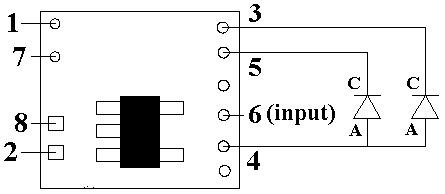
Figure 5
Select operating mode:
The NLA/D8063 can produce its special effects in one of two ways: either as a double pantograph (dual pickup) spark effect simulator or as one for a single pantograph. Many electrics have two pickups (one at each end of the locomotive or traction vehicle), while some such as earlier-era street trolleys may only have a single spring-loaded pole which contacts the catenary cable overhead.
By default, the NLA/D8063 is configured to produce spark effects on two separate LED outputs (one for each pantograph or pickup). The outputs of these 2 LEDs will be random and timed differently for each.
If a single pickup (and therefore single LED) is to be used, connect a wire between solder point 6 to — DC (solder point 2). This will cause all effects to be routed for only one LED connected to solder points 3 & 4.
Flicker control
Another new feature we've added to our low-voltage Simulator modules is solder-points for direct wiring of external capacitors for flicker control. These are solder points 7 and 8. When connecting external capacitance for this purpose, if multiple capacitors are used, they must be wired in parallel (all + connections together, and all – connections together). They must have a voltage rating of 16-volts or greater. The + (plus) connections are to be wired to solder point 7 and the – (minus) connections wired to point 8. For this Strobe Simulator, a capacitance value of 200 to 400uf should be sufficient.
This completes connection of the NLA/D8063 module. It is recommended that a thorough re-inspection of all connections and module placement be performed prior to applying power to the locomotive. We hope you enjoy the added realism our module provides.
© 2014 Ngineering





















